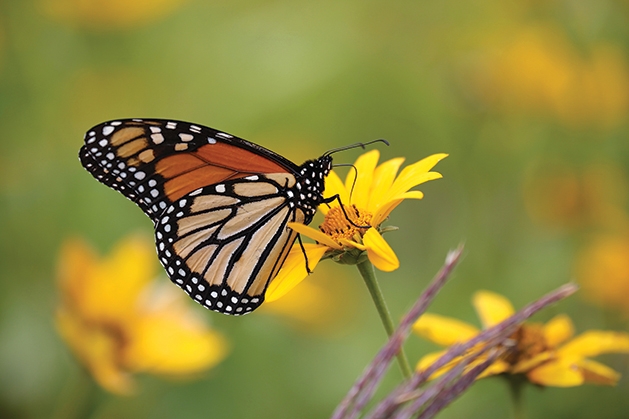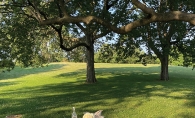
In December 2020, the U.S. Fish and Wildlife Service announced that the monarch butterfly became a candidate for the listing of the Endangered Species Act. While the listing has yet to be confirmed, the orange and black butterfly, easily one of the most recognizable species in the North America, is in trouble. But how and when did this happen?
“We’re losing habitat at the rate of two million acres per year,” says Mary Phillips, head of Garden for Wildlife by the National Wildlife Federation. “That includes both urban and suburban environments.”
Included in this habitat loss is the monarch’s lifeline—the milkweed plant. “It’s the only plant monarchs lay their eggs on,” Phillips says. “They still need other plants for nectar, but they don’t lay their eggs on those plants.”
The average adult monarch weighs less than one gram, and its overall size is about 4 inches. “It’s absolutely a canary in a coal mine,” Phillips says. “The fact that it’s so prolific and abundant, yet still declining is a real red flag.”
If there’s a silver lining to the butterflies’ declining numbers, it’s the attention it has generated. As national awareness has increased, so has the demand for native plantings. “In some cases … the demand outpaces supply,” Phillips says.
Anecdotally, Phillips says requests for her organization’s materials for planting habitat gardens for monarchs and other pollinators has increased five-fold over the last couple years. “People are building and expanding their gardens … and in the midst of a pandemic, they’ve had time, [50 percent more people have created certified wildlife habitat gardens in the last year]” she says.
Can a single garden really make a difference?
“Smaller might even be better when it comes to monarchs,” says Adam Baker, the technical advisor for the Davey Institute. Meaning, small urban gardens can make a large impact too. The key is to spatially arrange them in ways that can encourage reproduction in gardens.
Baker, who has a PhD. in pollinator ecology for conservation, has conducted research that shows large block plantings might not be as efficient as smaller plantings. “Perimeter and solitary milkweed plants generally get more eggs,” Baker says.
Baker’s research featured three garden plantings that were replicated six different times. One garden surrounded nectar-producing plants and ornamental grasses with a perimeter of milkweed plants. A second garden was the opposite—grasses and pollinators on the outside with milkweed plants in the inside. A third garden featured a mix of all three types of plants in a random patchwork arrangement.
“The garden with the milkweed on the perimeter attracted two-and-a-half to four times as many monarchs,” Baker says.
His other research shows that monarchs are more affected by visual cues than they are by olfactory cues. “To a monarch, sight is more important than smell,” he says.
Which variety is best?
There are over 100 varieties of milkweed in North America, and no two are the exact same. However, different varieties are suited for different tasks. “They serve different ecological niches,” Baker says. “The milkweed plant that is best depends on your goals. Do you want a more formal plant that stays put, or do you want a plant that might spread into your neighbor’s backyard?”
To understand which variety is best suited for your garden, Baker suggests starting with a small garden to eventually inspire further planting.
SPREADING THEIR WINGS
According to a U.S. Geological Survey study, the Eastern migratory population of monarch butterflies, which spend its winters in Mexico before migrating north to reproduce, has declined nearly 80 percent since 2007.
However, this number isn’t an exact science. Instead of counting individual butterflies, scientists estimate population size by measuring the geographic area the colonies of butterflies cover while overwintering in Mexico.
From 2015–2016, scientists estimated the monarchs’ overwintering area at about four hectares (one hectare is equivalent to about two-and-a-half acres). A year later, the estimate dropped to just below three hectares.
The goal for a sustainable population of monarchs, estimated at 127 million butterflies, is six hectares of overwintering area.
Scientists have concluded that it takes 28.5 milkweed stems to bring a single monarch to overwinter in Mexico. Extrapolated further, it takes 3.62 billion milkweed stems to support 127 million butterflies. However, the problem is, there’s only an estimated 1.8 billion milkweed stems in the ground
To improve, it’s going to happen one garden, one plant at a time.
To keep the momentum going, monarch supporters suggest action. “We can all encourage people to plant milkweed and nectar plants,” Phillips says. “And yes, one individual can make a difference.”
In June 2015, the National Pollinator Garden Network launched an effort called the Million Garden Challenge campaign, an effort to register a million gardens and landscapes to support pollinators. By December 2018, it surpassed its goal by eclipsing the one-million mark. Encouraging similar efforts is the Monarch Watch, which works to certify Monarch Waystations (like resting areas for butterflies) in various landscapes.
Though these organizations promote exponential growth, a simpler solution for progress involves a shovel and possibly a green thumb. Just like Baker says, smaller amounts of planting can be more beneficial in the long run.
Make your mark
While caterpillars feed exclusively on milkweed, monarch butterflies seek out many different varieties of milkweed to lay their eggs says Christina Timm, marketing manager for Lynde Greenhouse and Nursery. Milkweed is a crucial for the development for the caterpillar’s transition to butterfly, but there are many types of plants that provide nectar that are vital for the monarch butterfly to make its migration back to Mexico during the fall season.
“Late-blooming native plants are key, and incorporating a wide variety that produce high amounts of nectar is important,” Timm says.
Timm’s favorite native butterfly-attracting plants include milkweed, bee balm, joe-pye weed, asters, echinacea, liatris, goldenrod, ironweed and butterfly flower. With zinnias, lantanas, sweet alyssums and marigolds as the annuals she likes to add to the mix.
Three Plants to incorporate into your garden:
Joe-Pye Weed
Exposure: Full Sun
Bloom Time: Mid to Late summer
Joe-pye weed offers large rose-red flower heads on top of tall stems and full green foliage. It can provide vertical interest to your garden achieving 3 feet tall or more depending on variety. When it blooms during the summer, you will enjoy bees and monarch butterflies bouncing from flower head to flower head.
Butterfly Flower
Exposure: Sun or Part Sun
Bloom Time: Summer
The orange butterfly flower is native to Minnesota and offers bright orange clusters of flowers against bright, green and sturdy foliage. It provides food for monarch butterflies and acts as a host plant. Place this plant in the middle of a perennial garden, or use it as a border plant. This plant is also deer resistant.
Blazing Star Liatris
Exposure: Sun to Part Sun
Bloom Time: Summer
The blazing star liatris offer feather-like green foliage with shoots of purple flowers during the summer. These flower heads have the unusual habit of opening from top to bottom. This plant attracts the bees and butterflies with its stunning blooms.
National Wildlife Federation, info@gardenforwildlife.org; gardenforwildlife.org
Garden for Wildlife
@gardenforwildlife
@Garden4Wildlife
Lynde Greenhouse and Nursery, 9293 Pineview Lane N.; 763.420.4400; lyndegreenhouse.com
Lynde Greenhouse & Nursery
@lyndegreenhouse









